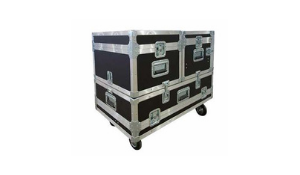What is an ATA case and how should you customize it?
11 April 2017

Many people don’t know what an ATA case is when they begin researching packaging to transport their equipment. Even more confusing, different industries refer to the same type of case by different names. The music and entertainment industry calls these cases road cases, and they are typically rectangular with casters, and store a variety of gear for a traveling band. Flight cases are usually smaller and can be used as luggage for transporting instruments or equipment on an airplane. Transit cases is a term used by the transportation industry.
ATA cases excel in reusability and mobility.
ATA cases provide optimal shipping protection for fragile or sensitive items. They are designed and reinforced to meet rigorous standards of durability and stand up to air handling and trucking. ATA cases excel in reusability, durability, ease of use, speed of loading and unloading and they can be used and reused many times (typically 100 or more uses). Because they are reused so many times, ATA cases are less expensive on a cost-per-trip basis than other modes of packaging.
Customize an ATA case to meet your unique needs or application.
With the addition of casters, an ATA case can become mobile and easy to handle. Similarly, an ATA case can include a fold out ramp so that heavy equipment can be rolled or slid out of the ATA case when it needs to be accessed. Sometimes your equipment needs to be partially or completely accessed while it is in the case. These examples of mobility and access illustrate different ways in which an ATA case can be configured for your application. Consider the entire journey of your equipment in an ATA case: all the people who will handle it, how it will be unpacked and repacked, even whether it will need to fit through a standard door. This will help you identify which areas of customization are the most important. For additional information, please see our blog on Guide to Ordering Custom ATA Cases.
Areas of Customization
Although heavier than hard shell cases such as Pelican, ATA cases have the important benefit that they can be customized to your needs. Optimal design for transit cases is the result of a collaborative process between you and your packaging and design engineers. Thinking about these areas of customization will help you create a better case for your equipment.
- Protection – Protecting your equipment from damage through blocking, bracing, foam design is most important.
- Mobility – The placement, size, and type of casters or handles can make your equipment much easier to move. Smaller cases can support telescoping handles (like luggage).
- Access – What features can ease the removal of the equipment from the case, or allow the equipment to be accessed in the case; a good starting point is to look at basic case styles.
- Organization – Are there multiple items that go with my ATA case: anything from paperwork, to multiple parts that need separate compartments to ease or speed assembly?
- Security – An ATA case hides your valuable equipment from prying eyes, and can be locked. Inner compartments can also be locked.
- Storage – Storing your equipment will protect it from the elements, make it easy to inventory, and ensure that it is in the same state as when it was packed.
- Transport – Your equipment may be handled by shipping carriers and others. Consider the environment, such as truck, airplane, and the geometry of doors, and elevators.
- Aesthetics – In many circumstances the look and feel of the exterior and the foam is important to your audience.
- Branding – Packaging represents the quality of your product and is often the first thing that customers see when your product arrives.
{{cta(‘c57cdc82-3a0b-4a93-ab49-3c3832076f79’)}}
